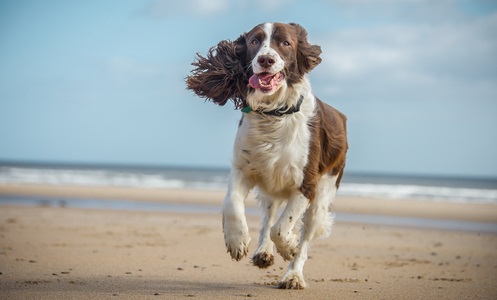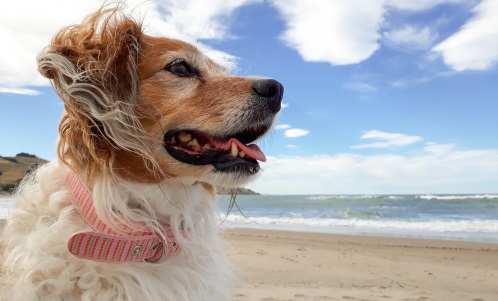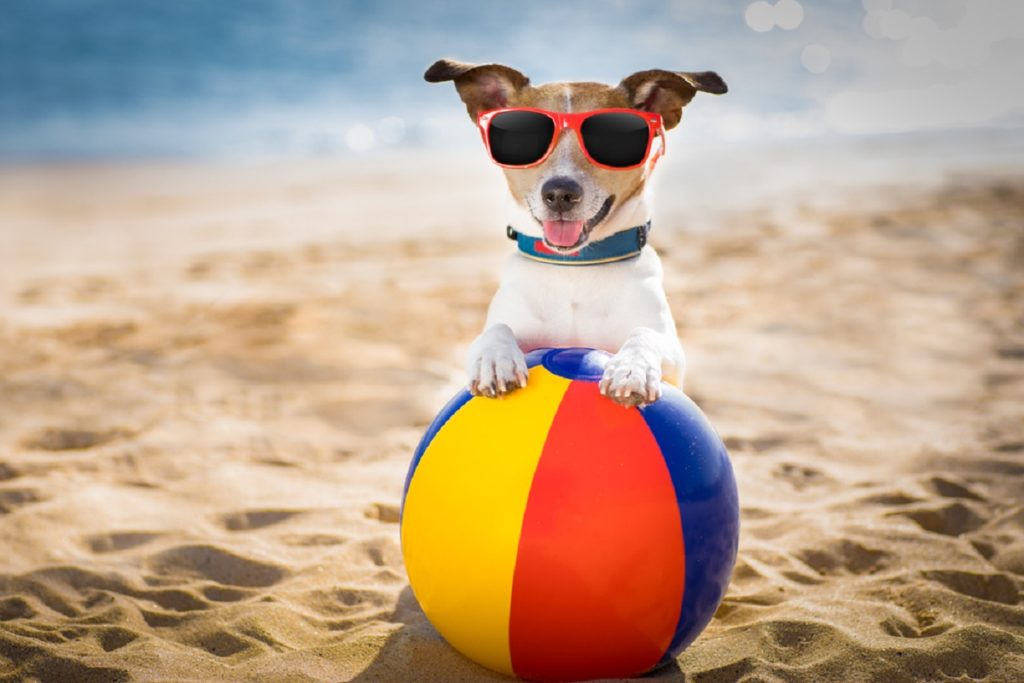Just like humans, most land-dwelling animals can acquire sunburns, and canines are certainly no exception. Interestingly, many animals exposed to high temperatures have acquired adaptations to evade or prevent overexposure. From the black tongue of giraffes to the mud-coating behavior of rhinos, non-domesticated animals have developed a number of ingenious ways of living under the sun’s harmful UV rays. Domesticated animals, on the other hand, don’t have such sophisticated approaches, other than seeking shade when the rays become too intense.
Whether in dogs or in humans, fair-skinned individuals are classified as “high risk” for sunburn due to lower levels of melanin in their skin. This skin-darkening pigment serves as a natural genetic remedy for preventing excessive UV-induced genetic damage, and is higher in darker colored skin. While melanin can be acquired through regular sun exposure or tanning, this period of melanin build-up requires repeated exposure over the course of several weeks, if not months, depending on the individual and level of sun exposure. If you have ever wondered, “Can dogs get sunburned?”, this post is for you.
Is Your Dog at Risk?
 Light Fur: Light-haired dogs have light skin, lower levels of melanin, and a higher risk of sunburn. Comparatively, dark-haired dogs have dark skin, higher levels of melanin, and a lower risk of sunburn.
Light Fur: Light-haired dogs have light skin, lower levels of melanin, and a higher risk of sunburn. Comparatively, dark-haired dogs have dark skin, higher levels of melanin, and a lower risk of sunburn.
Short or Thin Fur: But fur color isn’t the only factor, fur length and thickness should also be considered. Logically, dog breeds with short or thin fur are at a higher risk of sunburn, compared to dogs with long or thick fur. This makes sense given that more fur means better coverage.
- Dog breeds with short or thin fur: Italian Greyhound, Boston Terrier, Miniature Pinscher
No Fur: And it goes without saying, hairless dog breeds have the highest propensity for sunburns. If you have a hairless dog and live in a sunny climate, be sure to take additional measures to protect your dog’s exposed skin.
- Hairless Dog Breeds: Chinese Crested, American Hairless Terrier, Peruvian Inca Orchid
Puppies: Regardless of fur color, length, or thickness, puppies have sensitive skin that has little if no protection for UV rays. Just as you would take additional measures to protect a newborn baby, it is important to adopt added precautions to protect puppies and young dogs from overexposure as well.
Medical Conditions: This includes, but is not limited to alopecia, atopic dermatitis, flea infestation, fungal infection, and dogs with autoimmune diseases. Dogs with scar tissue, as well as skin exposed from a recent surgery, are also more vulnerable to canine sunburn.
Causes of Sunburn
A sunburn is a type of radiation injury caused by the harmful penetration of ultraviolet (UV) light, most commonly from the sun. As skin absorbs UV light, DNA directly absorbs these individual light particles, or photons. This not only causes potentially irreversible damage, but also elicits an inflammatory reaction, resulting in increased melanin production. Although the damage to DNA is not visible, repeated overexposure is the leading cause of skin cancer, and yes, dogs can get that too! Fortunately, cancer does not happen overnight; in fact, it takes several years to develop. What does happen immediately is inflammation, leading to red, hot, tender, and possibly even swollen skin. Once healed, increased melanin levels help to safeguard against similar damage in the near future. However, while melanin is a natural way to protect against a sunburn, it does not prevent it altogether.
Symptoms
Physically, sunburn symptoms are no different in dogs than they are in humans. Also, be on the lookout for behavioral signs associated with increased sensitivity or canine pain.
Physical Signs
- Visibly red or reddened skin
- Fur that is visibly lighter
- Skin that is dry, cracked, crusty, blistering or peeling
- Curling at the edges of the ears
Behavior Signs
- Continual scratching in the same, tender area
- Whimpering or shrinking away upon petting
- Difficulty walking normally, if the paws are affected
- Slight fever, if severe (Normal Dog Body Temperature: 101-102.5°F)
Each stated symptom may individually vary on a scale of mild, moderate, or severe. As with any illness, a higher degree of severity is typically indicated when more than one symptom occurs at the same time or in close succession. If you notice one symptom, immediately check for others. Whenever the level of severity is uncertain, consult your veterinarian.
Diagnosis and Treatment
Thankfully, the majority of sunburns are easily diagnosed. One thing to keep in mind is that dogs do not burn as easily as people. If you notice a visible sunburn, it is almost always more problematic than the eye can see. For this reason, veterinary care is recommended in all cases of obvious canine sunburn. When you take your dog to the vet, these are the types of solutions you can expect:
- Cold compresses provide immediate pain relief.
- Prescription of a cortisone ointment helps to reduce inflammation.
- Prescription of a topical antibacterial and antifungal agent works to prevent infection.
- Supportive therapy through intravenous fluids are performed in cases of extreme sunburn or heat exhaustion.
- If severe, a topical gel-based medication may be prescribed for daily wound cleansing.
Natural Ways to Heal a Sunburn
While veterinary care is recommended, light or barely visible sunburns are not usually a medical emergency. In the event a trip to the veterinarian is not necessary or feasible, there are a number of natural ways to relieve your dog’s inflammation.
- Aloe Vera: While general aloe vera creams and gels are safe to use as a means of immediate relief and expedited healing, ingestion is toxic. For this reason, it is important to only apply aloe vera to your dog when able to physically prevent licking shortly after. To prevent involuntary ingestion, avoid using aloe vera close to the eyes, nose, mouth, and inner ears.
- Cold Compress: Soak a clean cloth in ice cold water and apply the compress to the affected area in 15-minute intervals. You can also use an ice cube, ice pack, or bag of frozen peas – they all do the trick. Importantly, make sure not to apply the ice directly to the sunburn, as this could inflict excess drying.
- Cold Bath: If the burned area is widespread, consider a cold bath as an alternative to the above. While you want to make the bath as cold as possible, ice is not necessary. Similar to a cold compress, limit the bath to a maximum of 15 minutes. If cleansing as well, be certain to use mild soaps suitable for sensitive skin and apply gently.
- Oatmeal Bath: If you ever had the chicken pox as a child, you probably had an oatmeal bath. Regardless of skin condition, and whether in humans or dogs, oatmeal baths are known to provide soothing, instant relief. Using only lukewarm or cool water, let your dog soak as long as possible.
- Over-The-Counter Sprays: To temporarily relieve sunburn pain, consider using cooling sunburn relief sprays. Be warned, many of these sprays contain aloe vera, which is poisonous to dogs.
- Witch Hazel: Safe for dogs, and without the sting of rubbing alcohol, witch hazel is an effective solution for quick sunburn relief. To apply, lightly soak a cotton ball and gently dab the affected area. Repeat three to four times per day.
Choosing a Dog-Safe Sunscreen
 When shopping for a sunscreen suitable for your dog, check that the fragrance-free, non-staining solution contains both UVA and UVB barriers. Additionally, the sunscreen should have a minimum SPF of 15 and not contain Para-aminobenzoic acid (PABA) or Zinc Oxide. Both chemicals are common ingredients in most human-grade sunscreens and can result in serious health complications upon canine ingestion. As a general rule, only consider sunscreen that is either made for dogs or babies with sensitive skin.
When shopping for a sunscreen suitable for your dog, check that the fragrance-free, non-staining solution contains both UVA and UVB barriers. Additionally, the sunscreen should have a minimum SPF of 15 and not contain Para-aminobenzoic acid (PABA) or Zinc Oxide. Both chemicals are common ingredients in most human-grade sunscreens and can result in serious health complications upon canine ingestion. As a general rule, only consider sunscreen that is either made for dogs or babies with sensitive skin.
Tips to Remember and Share with Others
Tips: Preventing Sunburn Anywhere You Go
- Avoid Peak Hours (10:00 am to 4:00 pm): To avoid the hottest parts of the day, try to schedule walks in the morning and evening.
- Dog Hats: Sun hats are not just for humans, but for dogs too! Convincing your dog to adopt this sun-safe fashion, however, is another story. Have your dog try on a few styles – see what works, and what doesn’t. If all else fails, be sure to apply daily sunscreen as an equally effective alternative.
- Dog Suits: Full-coverage dog suits are best suited for hairless and short hair breeds in hot or sunny weather.
- Dog-Safe Sunscreen: Daily dog-safe sunscreen is the number one way to prevent sunburns, as well as protect your dog from easily preventable pain. So, what does it mean to be “Dog-Safe?” Sunscreen cannot contain these two chemicals:
- Para-aminobenzoic acid (PABA): Toxic, as well as fatal to dogs, early symptoms of ingestion include tremors, weakness, and vomiting in dogs.
- Zinc Oxide: While zinc oxide is toxic to dogs, it is generally only fatal if ingested multiple times or in large amounts. In a small dose, an upset stomach may result.
- Shade: Whether it’s an umbrella at the beach, easy-up at the park, or awning in your backyard, be sure to provide your dog with ample shade if outside during peak sun exposure hours.
- Test the Ground: To add to this, feel the pavement with the bottom of your foot or the palm of your hand before going for a walk. If it’s too hot for your bare feet, it’s too hot for your dog’s bare paws too! Whenever possible, opt for grass or dirt over high heat-absorbing surfaces, such as pavement and asphalt. A dog’s paws can not only get sunburned, but may be one of the most painful places to be injured due to constant paw-to-floor contact and pressure when walking.
Tips: Applying Sunscreen the Right Way
 Avoid Involuntary Ingestion: When applying dog-safe sunscreen, avoid extremities that could result in involuntary ingestion – eyes, nose, ears, and mouth. Canine-friendly sunscreen is safe to use, but just like humans, dogs don’t want it stinging or clogging the eyes or ears.
Avoid Involuntary Ingestion: When applying dog-safe sunscreen, avoid extremities that could result in involuntary ingestion – eyes, nose, ears, and mouth. Canine-friendly sunscreen is safe to use, but just like humans, dogs don’t want it stinging or clogging the eyes or ears.- Avoid Voluntary Ingestion: To add to the above, dogs may be curious or distressed by this use of sunscreen. While applying, and shortly thereafter, try to prevent your dog from licking it off. Even though dog-safe sunscreen is not toxic, it needs to stay on the skin (not the mouth!) to be effective.
- First, A Little: When using a new sunscreen, apply a few drops to a small part of your dog’s body. If no skin irritation occurs, you can then apply the product all over the skin.
- Pink Areas: Make sure to use sunscreen on any area that is pink, such as the belly, nose, and tips of the ears. Pink areas are more vulnerable to sunburn due to lack of pigment and protective fur.
Tips: Making Sunscreen Part of the Routine
- Keep Routines Separate: While it may seem like a good idea to get in the routine of applying your dog’s sunscreen at the same time you apply your own, this is not recommended. Upon combining routines, there is a higher likelihood of applying hazardous, human-grade sunscreen to your dog.
- Leash, Sunscreen, Walk, & Repeat: Instead, keep your dog-safe sunscreen next to the leash. Attach the leash, apply the sunscreen, optionally reward your dog with a treat, and let the morning walk begin! Safe, simple, and quick.
- Summer Beach Days: Remember to apply sunscreen before your dog sprints toward the sand or water. Otherwise, it could be a bit messy! Reapply as necessary and don’t forget to offer a little shade, especially if your dog is the type that enjoys belly-up sunbathing.
- Quick Ideas: To expedite the daily sunscreen routine, consider a type that sprays, or if using a cream, an application mitt for even, all-over coverage.
While summer may seem like a great time to give your dog a haircut and reduce shedding, cutting it too short may actually do more harm than good. This is especially important if you live in a warm weather climate. Whenever possible, opt for trims over cuts, and of course, use your best judgement. Whatever you do to protect yourself from sunburn, provide a similar solution for your dog. Whether it’s sunscreen, shade, hats, or suits, research and decide what’s best for your particular breed of dog. And most importantly, start to implement a sun safe routine, with all the essential products, as soon as possible.
Sources:
- “20 Short Haired Dogs With Low Grooming Needs.” PetCareRX, Accessed 18 May. 2019, https://www.petcarerx.com/article/20-short-haired-dogs-with-low-grooming-needs/147
- “Ask an Expert: Do Animals Get Sunburned?” Smithsonian, Accessed 14 May. 2019, https://www.smithsonianmag.com/science-nature/ask-an-expert-do-animals-get-sunburned-28218217/.
- “Can Dogs Wear Sunscreen?” PetMD, Accessed 14 May. 2019, https://www.petmd.com/dog/seasonal/can-dogs-wear-sunscreen.
- “Hairless Dog Breeds.” American Kennel Club, Accessed 18 May. 2019, https://www.akc.org/dog-breeds/hairless-dog-breeds/.
- “Is Aloe Gel Toxic to Dogs?” The Nest, Accessed 18 May. 2019, https://pets.thenest.com/aloe-gel-toxic-dogs-5970.html.
- “Opinion on 4-Aminobenzoic acid (PABA).” Scientific Committee on Consumer Products, Accessed 18 May. 2019,https://ec.europa.eu/health/ph_risk/committees/04_sccp/docs/sccp_o_058.pdf.
- “Sunburn and Your Dog.” VetWest Animal Hospitals, Accessed 14 May. 2019, https://www.vetwest.com.au/pet-library/sunburn-and-your-dog.
- “Sunburn in Dogs.” Wag!, Accessed 15 May. 2019, https://wagwalking.com/condition/sunburn.




